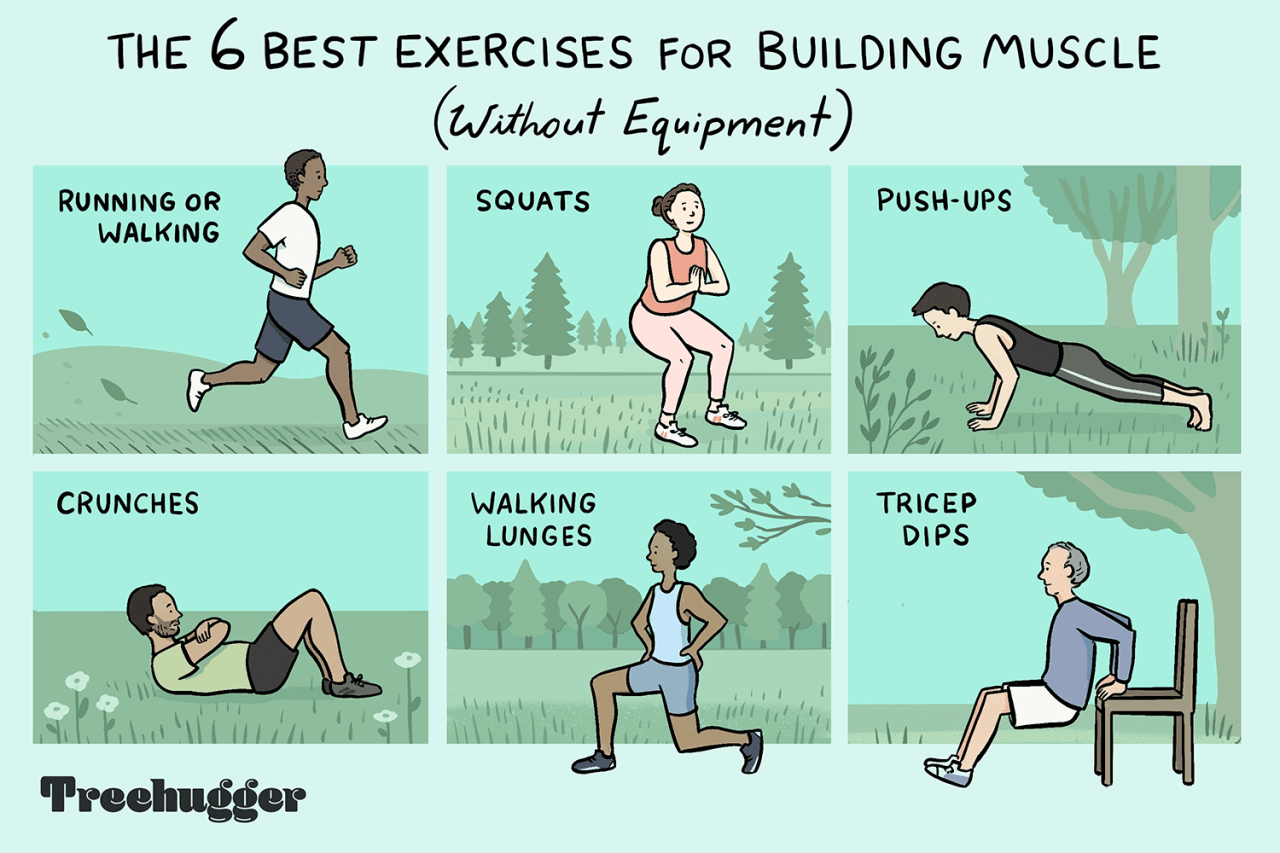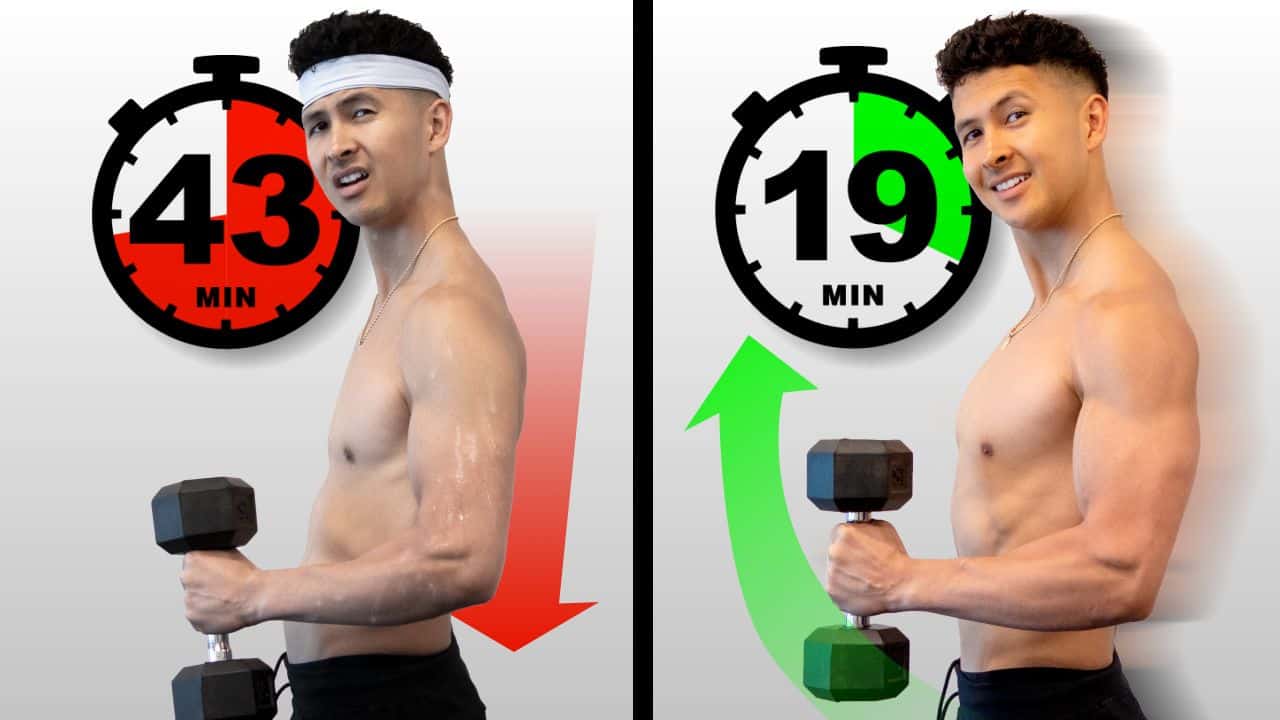How to build muscle and increase strength quickly? It’s a question echoing through gyms worldwide, a siren song of sculpted physiques and Herculean feats. Forget slow and steady; we’re diving headfirst into a world of accelerated gains, exploring the science of muscle growth, crafting killer workout routines, and fueling your body like a champion. Prepare to unleash your inner Adonis (or Amazon!), because this isn’t your grandma’s weightlifting guide.
This guide unravels the mysteries of muscle hypertrophy, revealing the secrets to building a powerful, aesthetic physique. We’ll dissect the science, design a training plan that’s as effective as it is efficient, and arm you with the nutritional knowledge to fuel your gains. We’ll tackle everything from proper form to avoiding common pitfalls, ensuring you’re not just building muscle, but building it
-smartly* and
-safely*.
Get ready to transform your body and redefine your limits.
Understanding the Fundamentals of Muscle Growth

So, you want to sculpt yourself into a human Greek statue? Fantastic! But before you start bench-pressing Volkswagens, let’s get down to the nitty-gritty of how muscles actually grow. It’s less about magically adding muscle and more about understanding a fascinating biological process. Think of it as a finely tuned engine – you need to know how it works to make it roar.Muscle hypertrophy, the fancy scientific term for muscle growth, is essentially the process of your muscles increasing in size.
This isn’t just adding more muscle cells (though that does happen to a small extent), it’s mainly about the existing muscle cells getting bigger and stronger. Imagine inflating a balloon – that’s kind of what’s happening at a cellular level.
The Role of Protein Synthesis in Muscle Building
Protein synthesis is the key player in this muscle-building drama. It’s the process where your body creates new proteins, the building blocks of muscle tissue. Think of it as your body’s internal construction crew, diligently laying down new bricks (proteins) to make your muscles bigger and stronger. This process is fueled by the protein you consume in your diet, so make sure you’re getting enough of the good stuff! A lack of sufficient protein is like trying to build a house without bricks – it’s not going to happen.
The rate of protein synthesis needs to exceed the rate of protein breakdown for muscle growth to occur. This is why proper nutrition is so crucial.
Progressive Overload in Strength Training
Progressive overload is the cornerstone of any successful strength training program. It’s simply the principle of continually challenging your muscles by gradually increasing the weight, reps, or sets you lift over time. Imagine trying to lift the same weight every workout – eventually, your muscles would adapt and stop growing. Progressive overload forces your muscles to constantly adapt and grow stronger, like a weightlifter gradually adding more weight to the bar, pushing their limits further and further.
This constant challenge is what triggers muscle growth. Think of it as a controlled form of muscle stress; your muscles adapt and get stronger to handle this increased demand.
Muscle Fiber Types and Their Role in Strength and Size Gains
Your muscles aren’t a homogenous blob; they’re composed of different types of muscle fibers, each with its own characteristics. We primarily have two main types: Type I (slow-twitch) and Type II (fast-twitch). Type I fibers are endurance champions, ideal for activities like long-distance running. Type II fibers, on the other hand, are the powerhouses, responsible for explosive movements like sprinting or weightlifting.
While both fiber types contribute to muscle growth, Type II fibers are particularly important for strength and size gains. Think of a marathon runner versus a sprinter – very different muscle compositions reflect the demands of their respective activities. Training programs should incorporate exercises that target both fiber types for optimal results. However, remember that genetics play a significant role in the proportion of each fiber type you possess.
Designing a Training Program for Rapid Muscle Growth and Strength Increase: How To Build Muscle And Increase Strength Quickly
So, you’re ready to sculpt yourself into a magnificent specimen of human strength and muscle? Fantastic! But haphazardly flinging weights around won’t cut it. We need a plan, a strategy, a meticulously crafted blueprint for your transformation from average Joe (or Jane) to muscle-bound marvel. Think of this training program not as a punishment, but as a meticulously planned heist – the heist of your best possible physique.
Designing a truly effective program hinges on understanding your body’s response to training, incorporating the right exercises, and allowing for sufficient recovery. We’ll focus on a balanced approach, blending the power of compound exercises (which work multiple muscle groups simultaneously) with the precision of isolation exercises (which target specific muscles). Remember, consistency is key; this isn’t a sprint, it’s a marathon (albeit one where you’re getting progressively more ripped).
A Sample 12-Week Training Program
This program is a template; adjust weights and reps based on your individual capabilities. Remember, proper form trumps weight every time. If you’re struggling with form, reduce the weight until you can perform the exercise correctly. Think quality over quantity; a perfect rep is far superior to ten sloppy ones.
| Week | Monday | Tuesday | Wednesday | Thursday | Friday | Saturday | Sunday |
|---|---|---|---|---|---|---|---|
| 1-4 | Full Body A | Rest | Full Body B | Rest | Full Body A | Rest | Rest |
| 5-8 | Upper Body A | Lower Body A | Rest | Upper Body B | Lower Body B | Rest | Rest |
| 9-12 | Push | Pull | Legs | Rest | Push | Pull | Legs |
Full Body A: Squats (3 sets of 8-12 reps), Bench Press (3 sets of 8-12 reps), Bent-Over Rows (3 sets of 8-12 reps), Overhead Press (3 sets of 8-12 reps), Bicep Curls (3 sets of 10-15 reps), Triceps Extensions (3 sets of 10-15 reps).
Full Body B: Deadlifts (1 set of 5 reps, 1 set of 3 reps, 1 set of 1 rep), Incline Dumbbell Press (3 sets of 8-12 reps), Pull-ups (as many reps as possible, 3 sets), Lunges (3 sets of 10-12 reps per leg), Calf Raises (3 sets of 15-20 reps).
Upper Body A/B and Lower Body A/B: These will involve variations of the exercises listed above, incorporating different angles and equipment (dumbbells, barbells, machines) to target muscles from various perspectives. Example: Instead of a barbell bench press, you might do dumbbell incline presses in a subsequent workout.
Push, Pull, Legs: This split focuses on pushing movements (chest, shoulders, triceps), pulling movements (back, biceps), and leg exercises in separate sessions. This allows for greater focus and intensity on each muscle group.
A Beginner-Friendly Full-Body Workout Split
Beginners should prioritize building a solid foundation of strength and proper form before moving to more advanced splits. A full-body routine allows for more frequent training of each muscle group, promoting faster gains in the initial stages.
Example Full Body Workout (3 days a week, with rest days in between):
- Squats (3 sets of 8-12 reps)
- Push-ups (3 sets to failure)
- Rows (3 sets of 8-12 reps)
- Overhead Press (3 sets of 8-12 reps)
- Plank (3 sets, 30-60 seconds hold)
Training Schedule and Recovery
Rest and recovery are just as crucial as the workouts themselves. Your muscles rebuild and grow during rest, not during the workout. Ignoring this fundamental principle is like trying to build a house without mortar – it’s going to crumble.
This schedule emphasizes adequate rest days to prevent overtraining and promote muscle growth. Listen to your body; if you’re excessively sore or fatigued, take an extra rest day.
The Importance of Proper Form and Technique
Executing exercises with impeccable form is paramount. Poor form not only reduces the effectiveness of the workout but also significantly increases the risk of injury. Imagine trying to build a skyscraper on a shaky foundation – it’s a recipe for disaster. Similarly, poor form undermines your gains and jeopardizes your health.
Before attempting any exercise with significant weight, familiarize yourself with the correct technique. Watch videos, consult with a trainer, or start with bodyweight exercises to master the movement pattern. Focus on controlled movements, avoiding jerky motions or using momentum to lift the weight. If you’re unsure about your form, it’s always best to err on the side of caution and reduce the weight or seek guidance.
Nutrition for Optimal Muscle Growth
Fueling your body for muscle growth isn’t about eating everything in sight; it’s a strategic approach to providing your muscles with the building blocks they need to get bigger and stronger. Think of it like this: you wouldn’t build a skyscraper with just sand, would you? Similarly, your muscles need the right mix of nutrients to reach their full potential.
Ignoring nutrition is like trying to win a race with flat tires – you might get somewhere, but it’ll be a lot slower and a lot more painful.
You also will receive the benefits of visiting Ultimate guide to weightlifting for beginners: exercises and schedule today.
Macronutrient Ratios for Muscle Growth
The foundation of a muscle-building diet rests on three macronutrients: protein, carbohydrates, and fats. These aren’t just calories; they are the raw materials your body uses to repair and rebuild muscle tissue, fuel your workouts, and support overall health. A common and effective ratio for muscle growth is approximately 40% carbohydrates, 30% protein, and 30% healthy fats. However, individual needs vary depending on factors like activity level, body composition, and metabolic rate.
This ratio serves as a useful starting point, and adjustments might be necessary based on your progress and response. Remember, consistency is key!
Protein Sources for Muscle Building
Protein is the undisputed king of muscle growth. It’s the building block of muscle tissue, and sufficient intake is crucial for repairing muscle fibers damaged during training. Aim to consume a gram of protein per pound of bodyweight daily, or even slightly more. A diverse range of protein sources ensures you get a wide array of essential amino acids.
| Protein Source | Protein per Serving (approx.) | Other Benefits |
|---|---|---|
| Chicken Breast | 30g (4oz) | Lean, versatile, readily available. |
| Salmon | 25g (4oz) | Rich in Omega-3 fatty acids, beneficial for overall health. |
| Lean Beef | 25g (4oz) | Good source of iron and zinc. |
| Greek Yogurt | 20g (1 cup) | High in protein and calcium. |
| Eggs | 6g (1 large) | Complete protein source, rich in vitamins and minerals. |
| Lentils | 18g (1 cup cooked) | Excellent source of plant-based protein and fiber. |
| Whey Protein Powder | 25g (1 scoop) | Convenient and quick way to increase protein intake. |
Carbohydrate Sources for Energy and Muscle Growth
Carbohydrates are your body’s primary energy source, especially important for fueling intense workouts. They also help replenish glycogen stores in your muscles, which are depleted during exercise. Opt for complex carbohydrates like whole grains, brown rice, sweet potatoes, and quinoa, which provide sustained energy release compared to simple sugars.
Healthy Fat Sources for Hormone Production and Overall Health
Healthy fats are essential for hormone production, which plays a crucial role in muscle growth and recovery. They also support overall health and well-being. Include sources like avocados, nuts, seeds, olive oil, and fatty fish in your diet.
Hydration: The Unsung Hero of Muscle Recovery
Water is often overlooked, but it’s vital for muscle recovery and overall bodily functions. Dehydration can impair muscle protein synthesis and hinder your progress. Aim to drink plenty of water throughout the day, especially before, during, and after workouts. Consider adding electrolytes if you sweat heavily. Think of water as the lubricant that keeps your muscle-building machine running smoothly.
Obtain a comprehensive document about the application of Best weightlifting routine for building strength and losing weight that is effective.
The Role of Supplements in Muscle Growth
Supplements can be helpful additions to a well-rounded diet, but they should not replace whole foods. Creatine monohydrate is a popular supplement that can increase strength and power output, while protein powder offers a convenient way to boost protein intake. However, remember that supplements are just that – supplements. They’re meant to complement a healthy diet and training program, not replace them.
Always consult a healthcare professional before starting any new supplement regimen.
Recovery and Rest for Muscle Growth
Building muscle isn’t just about lifting heavy; it’s about giving your body the time and tools it needs to rebuild stronger. Think of it like this: you’re demolishing a building (your muscles during workouts), and recovery is the crucial phase of construction, where the stronger, better version rises from the rubble. Neglecting this phase is like leaving a half-built house exposed to the elements – disaster! This section focuses on the vital role of recovery in maximizing your muscle growth and strength gains.
Sleep’s Role in Muscle Repair
Sufficient sleep is not a luxury; it’s a non-negotiable requirement for muscle growth. During sleep, your body releases growth hormone, a crucial player in muscle protein synthesis – the process where your muscles repair and grow. Aim for 7-9 hours of quality sleep per night. Imagine your muscles as tiny, hardworking construction workers; they need their downtime to recharge and get ready for the next building project (your next workout).
Chronic sleep deprivation significantly hampers this process, leading to slower recovery and reduced muscle growth. Studies have shown a direct correlation between adequate sleep and increased muscle mass and strength. For example, a study published in the
Journal of Strength and Conditioning Research* found that individuals who slept 8 hours a night experienced greater gains in muscle mass compared to those who slept less.
Stress Management for Muscle Recovery
Stress isn’t just bad for your mood; it’s a muscle-growth saboteur. Chronic stress elevates cortisol levels, a hormone that can break down muscle tissue. To combat this, incorporate stress-reducing techniques into your routine. This could involve meditation, yoga, spending time in nature, or engaging in hobbies you enjoy. Think of stress as a mischievous gremlin that steals building materials from your muscle construction site.
Effective stress management keeps the gremlin at bay, allowing your muscles to rebuild efficiently. Even simple techniques like deep breathing exercises can significantly reduce cortisol levels and promote relaxation.
Do not overlook the opportunity to discover more about the subject of muscular strength exercises.
Active Recovery Methods
Active recovery isn’t about hitting the gym again with the same intensity; it’s about gently stimulating blood flow and reducing muscle soreness. Light cardio, such as a leisurely walk or a swim, can be beneficial. Think of it as a light clean-up crew for your muscle construction site, removing debris and preparing the ground for the next phase of construction.
This type of activity promotes blood circulation, delivering nutrients and removing waste products, which aids in faster recovery. Furthermore, active recovery can improve mood and reduce stress, further contributing to optimal muscle growth.
Recognizing and Preventing Overtraining
Overtraining is the enemy of muscle growth. Signs include persistent fatigue, decreased performance, increased resting heart rate, and even mood changes. Prevention is key. This involves proper planning, including adequate rest days between workouts and listening to your body. Ignoring these signs is like pushing your construction workers beyond their limits; they’ll eventually strike, leading to decreased productivity (muscle growth).
Prioritize sleep, nutrition, and stress management to create a supportive environment for muscle recovery. Remember, consistency and patience are crucial for building muscle; rushing the process can lead to setbacks and injuries.
Common Mistakes to Avoid in Muscle Building

So, you’re ready to sculpt yourself into a Greek god or goddess? Fantastic! But before you start bench-pressing small cars, let’s talk about the pitfalls that can send your gains plummeting faster than a dropped dumbbell. Avoiding these common mistakes will keep you on track for serious strength and muscle growth.Ignoring the fundamentals is a recipe for disappointment.
Enhance your insight with the methods and methods of Advanced weight training program for experienced lifters to increase strength.
It’s like trying to bake a cake without flour – you might end up with something… interesting, but definitely not a cake. Similarly, neglecting proper form, nutrition, and recovery will sabotage your efforts.
Improper Lifting Technique
Using incorrect form during lifts is like trying to build a house on a shaky foundation. It not only limits your gains but significantly increases your risk of injury. Poor form often stems from lifting too heavy before mastering the movement. Start with lighter weights, focusing on perfect technique, and gradually increase the weight as you become stronger. Imagine a perfectly executed bicep curl: slow, controlled movement, feeling the muscle work, and avoiding momentum.
This is the key to maximizing results and minimizing the risk of injury. Contrast this with a jerky, momentum-driven lift where you’re using your body weight to swing the weight up—that’s a recipe for a pulled muscle, or worse.
Training Plateaus
Hitting a plateau is frustrating, but it’s a common part of the muscle-building journey. It often signifies that your body has adapted to your current routine. To break through a plateau, you need to shock your system. This could involve changing your training split, incorporating new exercises, adjusting the rep ranges, or experimenting with different training techniques like drop sets or supersets.
Think of it like this: if you always walk the same route, your body adapts and it becomes easier. To challenge yourself, you need to explore new routes, introducing different terrains and inclines.
Neglecting Nutrition, How to build muscle and increase strength quickly
Muscle growth is an anabolic process, requiring a surplus of calories to fuel the building of new muscle tissue. Neglecting proper nutrition is like trying to build a house without bricks. You need adequate protein intake to repair and rebuild muscle fibers after training. A balanced diet rich in carbohydrates for energy and healthy fats for hormone production is crucial.
Think of your body as a high-performance machine; you wouldn’t put low-grade fuel in a Ferrari, would you? Similarly, providing your body with the right nutrients is essential for optimal performance and muscle growth. Skipping meals or relying solely on fast food will drastically hinder your progress.
Insufficient Recovery
Recovery is just as important as training itself. Your muscles repair and grow during rest, not during your workouts. Insufficient sleep, chronic stress, and overtraining can lead to burnout and hinder muscle growth. Think of it like this: you wouldn’t expect a plant to grow if you never gave it water. Similarly, your body needs adequate rest to recover and grow stronger.
Prioritizing sleep, managing stress, and incorporating active recovery methods like light cardio or stretching will significantly improve your results.
Lack of Consistency and Patience
Building muscle takes time and dedication. There are no shortcuts. Consistency is key – showing up regularly and sticking to your plan is crucial. Patience is also essential. Don’t expect to see dramatic results overnight.
It’s a marathon, not a sprint. Think of a farmer tending to his crops – he doesn’t expect a harvest after a single day’s work. He understands the importance of consistent effort and patience over time. Similarly, consistent training, proper nutrition, and adequate rest will yield results in due course.
Visual Aids

Pictures are worth a thousand words, and when it comes to building muscle, seeing is believing! This section will bring the science of muscle growth to life, helping you visualize the process and perfect your technique. We’ll explore the intricate anatomy of your muscles, illustrate the perfect squat, and even create a mouth-watering visual representation of a muscle-building meal plan.
Muscle Anatomy: A Peek Under the Hood
Imagine your muscles as complex, interwoven ropes made of thousands of tiny fibers. These fibers, called muscle cells or myofibrils, are bundled together into larger units called fascicles. These fascicles, in turn, are wrapped in connective tissue, forming the muscle belly that you see and feel. Think of a well-organized cable – strong and flexible. Different muscles have different shapes and arrangements of these fibers, influencing their function.
For example, the biceps brachii, your classic “bicep,” is a fusiform muscle, meaning its fibers run parallel, giving it a long, tapering shape ideal for flexion (bending) of the elbow. In contrast, the deltoids, your shoulder muscles, have a multipennate structure, with fibers converging at various angles, allowing for a wide range of motion. This intricate arrangement allows for powerful movements and precise control.
The rectus abdominis, your “six-pack,” runs vertically along your abdomen, helping with flexion and stability of the torso. The gluteus maximus, your powerful glutes, are large and fan-shaped, extending from your hip to your thigh, responsible for hip extension and external rotation. Understanding this intricate arrangement helps you target specific muscles during your workouts.
Proper Squat Form: A Visual Guide
Picture a perfectly executed squat. Imagine your feet shoulder-width apart, toes slightly pointed outwards. Your spine remains neutral, like a straight line from head to tailbone. Your chest is up, and your gaze is forward, avoiding looking down. Your hips hinge back, as if you’re sitting back into an invisible chair.
Your knees track over your toes, avoiding inward or outward collapse. As you descend, your thighs should become roughly parallel to the ground, or slightly below, depending on your flexibility. The key muscles activated are your quadriceps (front of thighs), hamstrings (back of thighs), and glutes (buttocks). Feel the engagement in these areas; they are the engines powering your squat.
As you ascend, you forcefully extend your legs and hips, driving through your heels. The entire movement is controlled and powerful, emphasizing proper form over excessive weight. Imagine the smooth, efficient movement of a well-oiled machine.
A Balanced Meal Plan: A Feast for Your Muscles
Visualize a vibrant plate bursting with color and texture. Imagine a generous portion of grilled chicken breast (lean protein), showcasing its juicy texture and slightly browned edges. Alongside, a heaping mound of brown rice (complex carbohydrates), fluffy and steaming, provides sustained energy. Finally, a small serving of avocado (healthy fats) adds a creamy richness and essential fatty acids.
This represents a balanced macro-nutrient ratio, crucial for muscle growth. The chicken provides approximately 40% of the meal’s calories from protein, the rice approximately 40% from carbohydrates, and the avocado provides the remaining 20% from healthy fats. This combination fuels your muscles for intense workouts and aids in their repair and growth. The visual appeal is as important as the nutritional value; a delicious and satisfying meal encourages adherence to your diet.
Think of this not just as fuel, but as a delicious reward for your hard work.
Conclusion
So, there you have it – your express ticket to a stronger, more muscular you. Remember, building muscle isn’t just about lifting weights; it’s about strategic planning, consistent effort, and a healthy dose of self-belief. By combining the right training program, nutrition, and recovery strategies, you can accelerate your progress and achieve your physique goals faster than you ever thought possible.
Now go forth, conquer your workouts, and sculpt the body you’ve always dreamed of. Your transformation awaits!
